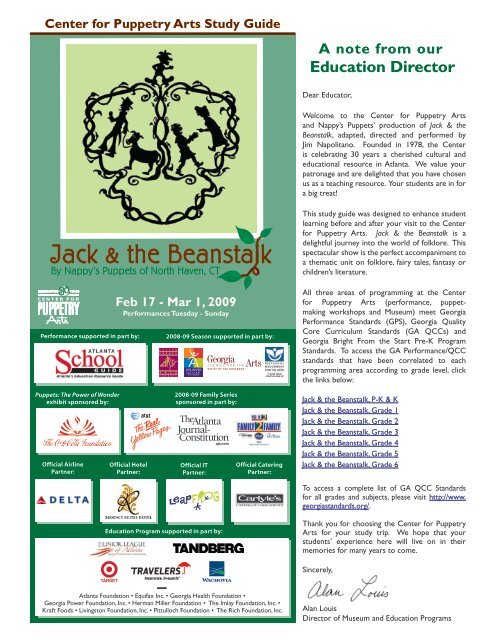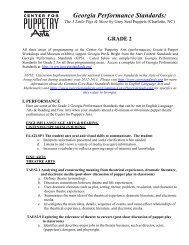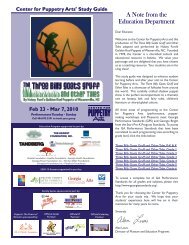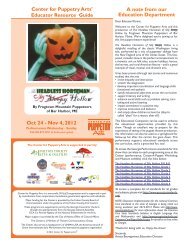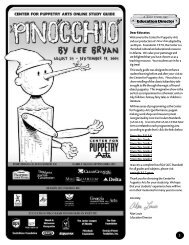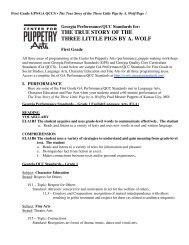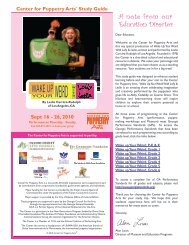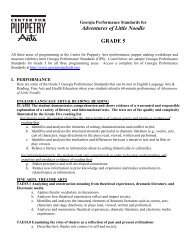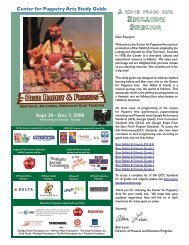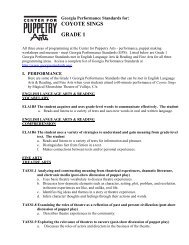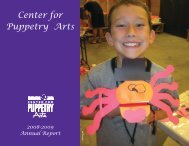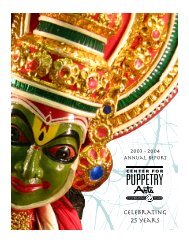Jack & the Beanstalk - Center for Puppetry Arts
Jack & the Beanstalk - Center for Puppetry Arts
Jack & the Beanstalk - Center for Puppetry Arts
You also want an ePaper? Increase the reach of your titles
YUMPU automatically turns print PDFs into web optimized ePapers that Google loves.
<strong>Center</strong> <strong>for</strong> <strong>Puppetry</strong> <strong>Arts</strong> Study Guide<br />
A note from our<br />
Education Director<br />
Dear Educator,<br />
Welcome to <strong>the</strong> <strong>Center</strong> <strong>for</strong> <strong>Puppetry</strong> <strong>Arts</strong><br />
and Nappy’s Puppets’ production of <strong>Jack</strong> & <strong>the</strong><br />
<strong>Beanstalk</strong>, adapted, directed and per<strong>for</strong>med by<br />
Jim Napolitano. Founded in 1978, <strong>the</strong> <strong>Center</strong><br />
is celebrating 30 years a cherished cultural and<br />
educational resource in Atlanta. We value your<br />
patronage and are delighted that you have chosen<br />
us as a teaching resource. Your students are in <strong>for</strong><br />
a big treat!<br />
This study guide was designed to enhance student<br />
learning be<strong>for</strong>e and after your visit to <strong>the</strong> <strong>Center</strong><br />
<strong>for</strong> <strong>Puppetry</strong> <strong>Arts</strong>. <strong>Jack</strong> & <strong>the</strong> <strong>Beanstalk</strong> is a<br />
delightful journey into <strong>the</strong> world of folklore. This<br />
spectacular show is <strong>the</strong> perfect accompaniment to<br />
a <strong>the</strong>matic unit on folklore, fairy tales, fantasy or<br />
children’s literature.<br />
Per<strong>for</strong>mance supported in part by:<br />
Feb 17 - Mar 1, 2009<br />
Per<strong>for</strong>mances Tuesday - Sunday<br />
2008-09 Season supported in part by:<br />
All three areas of programming at <strong>the</strong> <strong>Center</strong><br />
<strong>for</strong> <strong>Puppetry</strong> <strong>Arts</strong> (per<strong>for</strong>mance, puppetmaking<br />
workshops and Museum) meet Georgia<br />
Per<strong>for</strong>mance Standards (GPS), Georgia Quality<br />
Core Curriculum Standards (GA QCCs) and<br />
Georgia Bright From <strong>the</strong> Start Pre-K Program<br />
Standards. To access <strong>the</strong> GA Per<strong>for</strong>mance/QCC<br />
standards that have been correlated to each<br />
programming area according to grade level, click<br />
<strong>the</strong> links below:<br />
Puppets: The Power of Wonder<br />
exhibit sponsored by:<br />
Official Airline<br />
Partner:<br />
Official Hotel<br />
Partner:<br />
2008-09 Family Series<br />
sponsored in part by:<br />
Official IT<br />
Partner:<br />
Official Catering<br />
Partner:<br />
<strong>Jack</strong> & <strong>the</strong> <strong>Beanstalk</strong>, P-K & K<br />
<strong>Jack</strong> & <strong>the</strong> <strong>Beanstalk</strong>, Grade 1<br />
<strong>Jack</strong> & <strong>the</strong> <strong>Beanstalk</strong>, Grade 2<br />
<strong>Jack</strong> & <strong>the</strong> <strong>Beanstalk</strong>, Grade 3<br />
<strong>Jack</strong> & <strong>the</strong> <strong>Beanstalk</strong>, Grade 4<br />
<strong>Jack</strong> & <strong>the</strong> <strong>Beanstalk</strong>, Grade 5<br />
<strong>Jack</strong> & <strong>the</strong> <strong>Beanstalk</strong>, Grade 6<br />
To access a complete list of GA QCC Standards<br />
<strong>for</strong> all grades and subjects, please visit http://www.<br />
georgiastandards.org/.<br />
Education Program supported in part by:<br />
Thank you <strong>for</strong> choosing <strong>the</strong> <strong>Center</strong> <strong>for</strong> <strong>Puppetry</strong><br />
<strong>Arts</strong> <strong>for</strong> your study trip. We hope that your<br />
students’ experience here will live on in <strong>the</strong>ir<br />
memories <strong>for</strong> many years to come.<br />
Sincerely,<br />
Atlanta Foundation • Equifax Inc. • Georgia Health Foundation •<br />
Georgia Power Foundation, Inc. • Herman Miller Foundation • The Imlay Foundation, Inc. •<br />
Kraft Foods • Livingston Foundation, Inc. • Pittulloch Foundation • The Rich Foundation, Inc.<br />
Alan Louis<br />
Director of Museum and Education Programs
Synopsis<br />
All <strong>Jack</strong> wanted was to help his mo<strong>the</strong>r. But instead, he managed to set a giant on <strong>the</strong> loose! This classic folktale about<br />
a cattle sale gone wrong is based on <strong>the</strong> Appalachian version and is per<strong>for</strong>med in four parts by solo puppeteer Jim<br />
Napolitano of Nappy’s Puppets. Using vivid shadow puppetry, lively songs and humor, this master puppeteer tells <strong>the</strong><br />
story of <strong>Jack</strong> and his ill-fated beans, while working in o<strong>the</strong>r short stories, vignettes and songs too! The show features<br />
hand crafted shadow figures and is fast paced, action-packed, and full of laughs!<br />
About <strong>the</strong> Story<br />
The story of <strong>Jack</strong> and <strong>the</strong> <strong>Beanstalk</strong> is one of <strong>the</strong> most enduring fairy tales in <strong>the</strong> world. Versions of this story can be<br />
found in most cultures across <strong>the</strong> globe in one <strong>for</strong>m or ano<strong>the</strong>r. There are many folk tales from Germany in which<br />
<strong>the</strong> hero triumphs over a giant. In New Guinea, a legend is told of a young boy who, along with his mo<strong>the</strong>r, climbs<br />
a beanstalk to slay a human-eating giant named Tauni-kapi-kapi who represents <strong>the</strong> destructive power of storms.<br />
From Cornwall, England come <strong>the</strong> tales <strong>Jack</strong> Spriggins and <strong>the</strong> Enchanted Bean, <strong>Jack</strong> <strong>the</strong> Giant Killer and The History of<br />
Mo<strong>the</strong>r Twaddle and <strong>the</strong> Marvelous Achievements of Her Son <strong>Jack</strong>. There is even a Hawaiian version called Keaka and <strong>the</strong><br />
Lilikoi Vine, in which a boy trades his goat <strong>for</strong> <strong>the</strong> seeds of a passion fruit, or lilikoi. Common to all of <strong>the</strong>se stories<br />
is a mysterious plant that grows overnight, winding its way up through <strong>the</strong> clouds to a magical place of great wealth.<br />
The story of <strong>Jack</strong> and <strong>the</strong> <strong>Beanstalk</strong> has been a traditional holiday pantomime in England <strong>for</strong> hundreds of years and is<br />
frequently presented by puppeteers and acting companies in <strong>the</strong> United States year-round.<br />
Style of <strong>Puppetry</strong><br />
<strong>Jack</strong> and <strong>the</strong> <strong>Beanstalk</strong> is per<strong>for</strong>med with shadow puppets, which are jointed figures that are cut from sheets of<br />
cardboard or plastic. The audience never actually sees <strong>the</strong> puppet itself but its shadow, or silhouette. The puppets<br />
have control rods attached to different parts of <strong>the</strong> puppets’ bodies. The puppeteer is behind an illuminated shadow<br />
screen holding <strong>the</strong> control rods and pressing <strong>the</strong> shadow puppets directly against <strong>the</strong> back of <strong>the</strong> screen. By<br />
manipulating <strong>the</strong> control rods, <strong>the</strong> puppeteer can make <strong>the</strong> puppets act out <strong>the</strong> story on <strong>the</strong> shadow screen. All of<br />
<strong>the</strong> character voices and sound effects are per<strong>for</strong>med live by <strong>the</strong> puppeteer.<br />
About <strong>the</strong> Artist<br />
Jim Napolitano is a native of Mil<strong>for</strong>d, Connecticut and a graduate of <strong>the</strong> University of Connecticut’s Puppet <strong>Arts</strong><br />
Program. After completing his degree, Jim worked with Bits n’ Pieces Puppet Theater per<strong>for</strong>ming around <strong>the</strong> country<br />
and around <strong>the</strong> world including stops in Japan and Taiwan. Jim is now a freelance artist and per<strong>for</strong>mer. Jim’s work can<br />
be seen on Between <strong>the</strong> Lions, The Book of Pooh, The Weinerville Chanukah Special, A Show of Hands and Stick Stickly.<br />
Jim Napolitano<br />
of Nappy’s Puppets<br />
© 2009 <strong>Center</strong> <strong>for</strong> <strong>Puppetry</strong> <strong>Arts</strong>. All Rights Reserved.<br />
2
Bibliography<br />
• Bofill, Francesca. Juan y los Frijoles Magicos. Chronicle Books, 1998.<br />
• Briggs, Raymond. Jim and <strong>the</strong> <strong>Beanstalk</strong>. Sandcastle Books, 1970.<br />
• Dahl, Roald. The BFG. Farrar, Straus & Griroux, 1982.<br />
• Galdone, Paul. The History of Mo<strong>the</strong>r Twaddle and <strong>the</strong> Marvelous Achievements of her<br />
Son <strong>Jack</strong>. The Seabury Press, 1974.<br />
• Grawowsky, Dr. Alvin. Giants Have Feelings, Too/<strong>Jack</strong> and <strong>the</strong> <strong>Beanstalk</strong><br />
(Ano<strong>the</strong>r Point of View). Raintree/Steck-Vaughn, 1996.<br />
• Haley, Gail E. <strong>Jack</strong> and <strong>the</strong> Bean Tree. Crown Publishers Inc, 1986.<br />
• Haviland, Virginia. Favorite Fairy Tales Told in England. Beech Tree Books, 1994.<br />
• Jordan, Helene J. How a Seed Grows (Let’s-Read-and-Find-Out Science 1).<br />
HarperTrophy (revised edition) 1992.<br />
• Kalman, Bobbie. How a Plant Grows. Crabtree Publishing Company, 1996.<br />
• Kellog, Steven. <strong>Jack</strong> and <strong>the</strong> <strong>Beanstalk</strong>. HarperTrophy, 1997.<br />
• Laird, Donivee Martin. Keaka and <strong>the</strong> Lilikoi Vine. Barnaby Books, 1982.<br />
• Osborne, Mary Pope. Kate and <strong>the</strong> <strong>Beanstalk</strong>. A<strong>the</strong>neum/Anne Schwartz<br />
Books, 2000.<br />
• Rose, Carol. Giants, Monsters and Dragons: An Encyclopedia of Folklore, Legend<br />
and Myth. W.W. Norton and Company, 2001.<br />
• Steig, Jeanne. A Handful of Beans. Harper Collins Publishers, 1998.<br />
• Walker, Paul R. Giants! Stories from Around <strong>the</strong> World. Harcourt Brace & Co., 1995.<br />
• Wilde, Oscar. The Selfish Giant. Puffin Books, 1982.<br />
© 2009 <strong>Center</strong> <strong>for</strong> <strong>Puppetry</strong> <strong>Arts</strong>. All Rights Reserved.<br />
3
Internet Resources<br />
http://www.nappyspuppets.com/<br />
Visit your puppeteer pal Jim Napolitano online.<br />
http://www.nationalgeographic.com/grimm/<br />
Learn about <strong>the</strong> Grimm Bro<strong>the</strong>rs at <strong>the</strong> National Geographic website.<br />
http://www.usm.edu/english/fairytales/jack/jackhome.html<br />
Visit an online archive where you can read and compare several different English versions of<br />
<strong>Jack</strong> and <strong>the</strong> <strong>Beanstalk</strong>.<br />
http://www.pitt.edu/~dash/grimm.html<br />
Visit this site <strong>for</strong> a comprehensive Grimm Bro<strong>the</strong>rs database with links to many folk and fairy tale sites.<br />
http://www.its-behind-you.com/jackandbean.html<br />
See pictures from a traditional English pantomime of <strong>Jack</strong> and <strong>the</strong> <strong>Beanstalk</strong>.<br />
http://www.absolute1.net/jack-&-<strong>the</strong>-beanstalk.html<br />
Visit this website to read an illustrated version of <strong>the</strong> story of <strong>Jack</strong> and <strong>the</strong> <strong>Beanstalk</strong> online.<br />
http://www.crazy<strong>for</strong>cows.com/<br />
Are you crazy <strong>for</strong> cows? Come join <strong>the</strong> herd and celebrate all things bovine at crazy<strong>for</strong>cows.com.<br />
http://www.gold.org/discover/knowledge/faqs/<br />
Visit <strong>the</strong> World Gold Council online to learn interesting facts about gold.<br />
http://www.gandolf.com/cornwall/giants/introduction.shtml<br />
Learn about <strong>the</strong> mythical giants of Cornwall, England at this unique and fascinating website.<br />
Vintage illustration from Tenggren’s <strong>Jack</strong> and <strong>the</strong> <strong>Beanstalk</strong>,<br />
Golden Press 1953<br />
© 2009 <strong>Center</strong> <strong>for</strong> <strong>Puppetry</strong> <strong>Arts</strong>. All Rights Reserved.<br />
4
Learning Activities<br />
P-K & K: Comparing Two <strong>Jack</strong> and <strong>the</strong> <strong>Beanstalk</strong> Stories<br />
Georgia Bright from <strong>the</strong> Start Pre-K Content Standards covered: Language & Literacy: LD1<br />
b, d; LD5 a, b. GA Per<strong>for</strong>mance Standards (GPS) covered: Kindergarten, English Language <strong>Arts</strong>,<br />
Reading (Vocabulary): ELAKR5, (Comprehension): ELARK6, (Listening/Speaking/Viewing): ELAKLSV1.<br />
Objective: Students will employ critical thinking skills to compare and contrast elements of two<br />
versions of <strong>the</strong> same fairy tale.<br />
Materials: Copies of one or two different <strong>Jack</strong> and <strong>the</strong> <strong>Beanstalk</strong> picture books (see Bibliography<br />
section of this study guide), chart paper, colored markers.<br />
Procedure:<br />
1. Be<strong>for</strong>e attending a per<strong>for</strong>mance of Jim Napolitano’s <strong>Jack</strong> and <strong>the</strong> <strong>Beanstalk</strong> at <strong>the</strong> <strong>Center</strong> <strong>for</strong><br />
<strong>Puppetry</strong> <strong>Arts</strong>, read a picture book version of <strong>Jack</strong> and <strong>the</strong> <strong>Beanstalk</strong> to your students. After you<br />
return from <strong>the</strong> per<strong>for</strong>mance, re-read <strong>the</strong> picture book. Ask <strong>the</strong>m to compare <strong>the</strong> story in book<br />
<strong>for</strong>m to <strong>the</strong> puppet show. (If you are not attending <strong>the</strong> per<strong>for</strong>mance, compare two versions of<br />
<strong>the</strong> story from <strong>the</strong> Bibliography section of this study guide).<br />
2. On chart paper, make a simple Venn diagram (see Fig. 1). Label one circle “Book” and <strong>the</strong><br />
o<strong>the</strong>r “Puppet Show.” You may want to use three different colored markers when filling in<br />
your chart.<br />
3. Ask students to recall details that are unique to each version and list <strong>the</strong>m in <strong>the</strong> corresponding<br />
circles. Then, ask students to think of elements that are <strong>the</strong> same in both versions. List <strong>the</strong>se<br />
details in <strong>the</strong> space where <strong>the</strong> circles overlap.<br />
4. Display Venn diagram in classroom surrounded by student drawings depicting scenes from each<br />
of <strong>the</strong> two stories.<br />
Assessment: Monitor student participation/responses <strong>for</strong> comprehension of comparing and<br />
contrasting. Save students’ drawings <strong>for</strong> Language <strong>Arts</strong> portfolios.<br />
© 2009 <strong>Center</strong> <strong>for</strong> <strong>Puppetry</strong> <strong>Arts</strong>. All Rights Reserved.<br />
Vintage illustration from<br />
Tenggren’s <strong>Jack</strong> and <strong>the</strong> <strong>Beanstalk</strong>,<br />
Golden Press 1953<br />
5
© 2009 <strong>Center</strong> <strong>for</strong> <strong>Puppetry</strong> <strong>Arts</strong>. All Rights Reserved.<br />
6
Learning Activities<br />
1st & 2nd Grade: Plant your Own <strong>Beanstalk</strong>!<br />
Georgia Per<strong>for</strong>mance Standards covered: Grade 1, English Language <strong>Arts</strong>, Reading (Concepts<br />
of Print): ELAR1; English Language <strong>Arts</strong>, Writing: ELA1W1. Science, Life Science: S1L1. Second Grade,<br />
English Language <strong>Arts</strong>, Writing: ELA2W1.<br />
Objective: Students will plant a bean seed and observe and describe <strong>the</strong> plant parts as <strong>the</strong>y grow<br />
and change.<br />
Materials: Clear plastic or Styrofoam cup or small clay pot, potting soil, 3-4 bean seeds, water, writing<br />
journal, pencil. (The advantage of a clear plastic cup is that students may be able to view <strong>the</strong>ir plant’s<br />
roots in <strong>the</strong> soil.)<br />
Procedure:<br />
1. Fill cup/pot with soil about half way. To incorporate fractions into <strong>the</strong> lesson, ask students to fill<br />
<strong>the</strong>ir cups one quarter full, <strong>the</strong>n half full.<br />
2. Plant <strong>the</strong> seeds and cover with soil until <strong>the</strong> cup/pot is about three quarters full.<br />
3. Water and place in a sunny spot.<br />
4. Have students recall <strong>the</strong> steps up to this point and record in <strong>the</strong>ir journals. Draw a picture and<br />
be sure that every journal entry includes <strong>the</strong> date.<br />
5. Students should observe beanstalk every o<strong>the</strong>r day and draw a picture of <strong>the</strong>ir observations.<br />
Some days may have no change. That is okay; have <strong>the</strong>m record it anyway.<br />
6. When beans begin to grow, have students measure <strong>the</strong> height of <strong>the</strong>ir plants and record <strong>the</strong><br />
results in <strong>the</strong>ir journals. Students should label each part of <strong>the</strong> plant: stem, leaves and even<br />
<strong>the</strong> roots below <strong>the</strong> surface if visible. By now, plants may be getting too large <strong>for</strong> <strong>the</strong> cup/pot<br />
<strong>the</strong>y were planted in and will need to be replanted into a larger container with more soil. Ask<br />
students to predict what would happen if <strong>the</strong> plant continued to keep growing in too small<br />
a space.<br />
Assessment: Check student journals <strong>for</strong> completion. Ask students to recall from memory <strong>the</strong><br />
process of <strong>the</strong>ir plant’s growth from <strong>the</strong> first day to <strong>the</strong> last.<br />
© 2009 <strong>Center</strong> <strong>for</strong> <strong>Puppetry</strong> <strong>Arts</strong>. All Rights Reserved.<br />
7
Learning Activities<br />
3rd & 4th Grade: Research Your Favorite Exotic Plant<br />
Georgia Per<strong>for</strong>mance Standards covered: Grade 3, English/Language <strong>Arts</strong> (ELA), Writing, ELA3W1.<br />
Grade 4, Language <strong>Arts</strong>, Written Communication (Reading): 13, 16, 17, 21; (Writing): 39, 40, 41. Social<br />
Studies, Core Social Studies Skills (In<strong>for</strong>mation Processing): 24, 25, 26, 36. Georgia Per<strong>for</strong>mance<br />
Standards covered: Grade 4, English/Language <strong>Arts</strong> (ELA), Writing, ELA4W2.<br />
Objective: Students will select an exotic plant to research and <strong>the</strong>n write a report on <strong>the</strong>ir findings.<br />
Materials: Paper, pencils, computers with Internet access, access to school media center and/or public<br />
library. This website may be helpful: http://www.worldplants.com/.<br />
Procedure:<br />
1. Prewriting. Teacher should guide students through a brainstorming session to list different<br />
exotic plants such as Venus Flytrap, Strawberry Guava, Blueberry Flax, etc. Make sure students<br />
understand <strong>the</strong> difference between commonplace and exotic.<br />
2. Research. Ask each student to select a type of exotic plant that <strong>the</strong>y would like to learn more<br />
about. Once <strong>the</strong>y have chosen a plant to research, <strong>the</strong>y should locate books, encyclopedias,<br />
digital media and websites on <strong>the</strong> Internet to ga<strong>the</strong>r in<strong>for</strong>mation about <strong>the</strong>ir species. They may<br />
also conduct an interview with a botanist in person, email or by telephone.<br />
3. Drafting. Students should use research finding to complete <strong>the</strong> first draft. Ask students to<br />
address <strong>the</strong> following points:<br />
• Describe your plant’s appearance.<br />
• In what type of climate does your plant grow?<br />
• In what part of <strong>the</strong> world is your plant found?<br />
• Does your plant produce flowers? Fruit? Berries?<br />
• Is your plant poisonous to humans or animals?<br />
• Do humans use your plant to manufacture a product?<br />
4. Revising and Editing. Have students prepare a first draft of <strong>the</strong>ir report <strong>for</strong> editing. Ask students<br />
to draw an illustration of what <strong>the</strong>ir exotic plant looks like.<br />
5. Publishing. Final drafts should be presented be<strong>for</strong>e <strong>the</strong> class.<br />
Assessment: Check to see if students have followed <strong>the</strong> writing process: prewriting, drafting, editing<br />
and publishing. Save finished reports <strong>for</strong> student writing portfolios.<br />
© 2009 <strong>Center</strong> <strong>for</strong> <strong>Puppetry</strong> <strong>Arts</strong>. All Rights Reserved.<br />
8
Learning Activities<br />
5th & 6th Grade: How Do Folk Tales Change Over Time?<br />
Georgia Per<strong>for</strong>mance Standards covered: Grade 5, English/Language <strong>Arts</strong> (ELA):<br />
Reading: ELA5R1; Writing: ELA5W1; Sixth Grade, English/Language <strong>Arts</strong> (ELA), Reading: ELA6RC2;<br />
Writing: ELA6W1.<br />
Objective: Students will compare and contrast two different versions of <strong>Jack</strong> and <strong>the</strong> <strong>Beanstalk</strong> – one<br />
recent children’s picture book of <strong>the</strong>ir own choosing and <strong>Jack</strong> <strong>the</strong> Giant Killer from an 1898 book of fairy<br />
tales. Then students will report on <strong>the</strong>ir findings.<br />
Materials: Computers with Internet access and printers, a copy of <strong>Jack</strong> and <strong>the</strong> <strong>Beanstalk</strong>, paper<br />
and pencils.<br />
Procedure:<br />
1. Students should find a recent picture book of <strong>Jack</strong> and <strong>the</strong> <strong>Beanstalk</strong> and check it out from <strong>the</strong><br />
school media center or public library and bring it to class.<br />
2. Next, have students go online and print out <strong>the</strong> 1898 version of <strong>Jack</strong> <strong>the</strong> Giant-Killer<br />
from http://www.2020site.org/robbinhood/jackgiant.html.<br />
3. After reading both versions of <strong>the</strong> story, students should consider <strong>the</strong>se questions:<br />
• What is <strong>the</strong> main difference between <strong>the</strong> two versions?<br />
• How many years have passed since <strong>Jack</strong> <strong>the</strong> Giant Killer was written?<br />
(Subtract 1898 from current year)<br />
• How is <strong>the</strong> language different? Give specific examples.<br />
• How are <strong>the</strong> characters in <strong>the</strong> story different?<br />
• How is <strong>the</strong> plot different?<br />
• What values are represented in each? Is <strong>the</strong> purpose of <strong>the</strong> story different?<br />
• Why do you think <strong>the</strong> story has changed so much in 100 years? Do you feel that<br />
<strong>Jack</strong> <strong>the</strong> Giant Killer is appropriate <strong>for</strong> young children today? Was it ever an<br />
appropriate story <strong>for</strong> young children? Why or why not?<br />
4. Ask students to write an essay stating <strong>the</strong>ir observations and conclusions.<br />
Assessment: Have students share <strong>the</strong>ir essays with <strong>the</strong> class. Check <strong>for</strong> comprehension of discussion<br />
questions. Save essays <strong>for</strong> Language <strong>Arts</strong> writing portfolios.<br />
<strong>Center</strong> <strong>for</strong> <strong>Puppetry</strong> <strong>Arts</strong> is a non-profit, 501(c)(3) organization and is supported in part by contributions from corporations,<br />
foundations, government agencies, and individuals. Major funding <strong>for</strong> <strong>the</strong> <strong>Center</strong> is provided by <strong>the</strong> Fulton County Board of Commissioners under <strong>the</strong><br />
guidance of <strong>the</strong> Fulton County <strong>Arts</strong> Council. Major support is provided by <strong>the</strong> City of Atlanta Office of Cultural Affairs. These programs are<br />
supported in part by <strong>the</strong> Georgia Council <strong>for</strong> <strong>the</strong> <strong>Arts</strong> (GCA) through <strong>the</strong> appropriations from <strong>the</strong> Georgia General Assembly. GCA is a Partner<br />
Agency of <strong>the</strong> National Endowment <strong>for</strong> <strong>the</strong> <strong>Arts</strong>. The <strong>Center</strong> is a participant in <strong>the</strong> New Generations Program, funded by <strong>the</strong> Doris Duke Charitable<br />
Foundation/The Andrew W. Mellon Foundation and administered by Theatre Communications Group (TCG), <strong>the</strong> national organization <strong>for</strong> <strong>the</strong><br />
American Theatre. The <strong>Center</strong> is a Member of TCG and <strong>the</strong> Atlanta Coalition of Per<strong>for</strong>ming <strong>Arts</strong>. The <strong>Center</strong> also serves as headquarters of<br />
UNIMA-USA, <strong>the</strong> American branch of Union Internationale de la Marionnette, <strong>the</strong> international puppetry organization.<br />
9
Study Guide Feedback Form<br />
The following questions are intended <strong>for</strong> teachers and group leaders<br />
who make use of <strong>the</strong> <strong>Center</strong> <strong>for</strong> <strong>Puppetry</strong> <strong>Arts</strong>’ study guides.<br />
1. In what grade are your students?<br />
2. Which show did you see? When?<br />
3. Was this your first time at <strong>the</strong> <strong>Center</strong>?<br />
4. Was this <strong>the</strong> first time you used a <strong>Center</strong> Study Guide?<br />
5. Did you download/use <strong>the</strong> guide be<strong>for</strong>e or after your field trip?<br />
6. Did you find <strong>the</strong> bibliography useful? If so, how?<br />
7. Did you find <strong>the</strong> list of online resources useful? If so, how?<br />
8. Did you reproduce <strong>the</strong> grade-appropriate activity sheet <strong>for</strong> your class?<br />
9. Additional in<strong>for</strong>mation and/or comments:<br />
Please fax back to <strong>the</strong> <strong>Center</strong> <strong>for</strong> <strong>Puppetry</strong> <strong>Arts</strong> at 404.873.9907.<br />
Your feedback will help us to better meet your needs. Thank you <strong>for</strong> your help!<br />
1404 Spring Street, NW at 18th • Atlanta, Georgia USA 30309-2820<br />
Ticket Sales: 404.873.3391 • Administrative: 404.873.3089 • www.puppet.org • info@puppet.org<br />
Headquarters of UNIMA-USA • Member of Atlanta Coalition of Per<strong>for</strong>ming <strong>Arts</strong> and Theatre Communications Group<br />
Text by Alan Louis • Design by Melissa Sims • © <strong>Center</strong> <strong>for</strong> <strong>Puppetry</strong> <strong>Arts</strong> Education Department, February 2009.


